Far North Queensland (FNQ) is home to a rich and diverse avifauna or birdlife. With its mix of ecosystems including rainforests, wetlands, and savannas, FNQ is a prime destination for birdwatchers and ornithologists alike.
The region boasts of more than 400 species of birds, including some of Australia’s most iconic, such as the Southern Cassowary, the Australian Bustard, and the Palm Cockatoo.
FNQ’s unique geography and subtropical climate provide an ideal environment for many bird species to thrive, making it a birdwatcher’s paradise.
Whether you are a seasoned birder or a novice, there is something captivating and exciting about the birds in FNQ.
1. Olive-Backed Sunbird
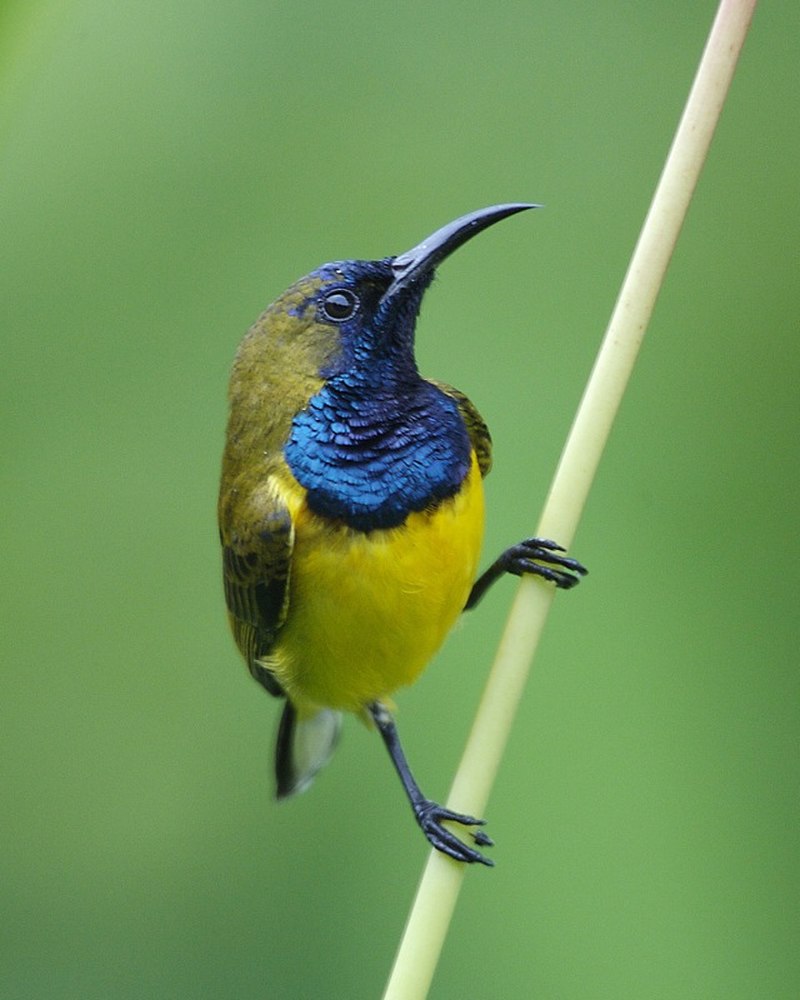
The Olive-backed Sunbird is a vibrant species of sunbird found in Southern Asia and Australia. Its striking yellow underbelly complements its olive upperparts, making it an attractive sight to behold.
First described by Mathurin Jacques Brisson in 1760 based on a specimen from the Philippines, this small songbird loves nectar but will also feed on insects as well as other tiny invertebrates.
It feeds mainly while hovering or perching with its bill pointing downwards – quite an impressive feat.
This bird has adapted to both forested areas and urban gardens meaning they can be seen all over their range.
With conservation efforts in place for this beautiful creature we are sure that the Olive-backed Sunbird will continue to bring joy to our lives for many years yet.
Scientific classification:
| Kingdom | Animalia |
| Phylum | Chordata |
| Class | Aves |
| Order | Passeriformes |
| Family | Nectariniidae |
| Genus | Cinnyris |
| Species | C. jugularis |
Also Featured In: Birds of the Philippines, Common Philippines Birds
2. Southern Cassowary
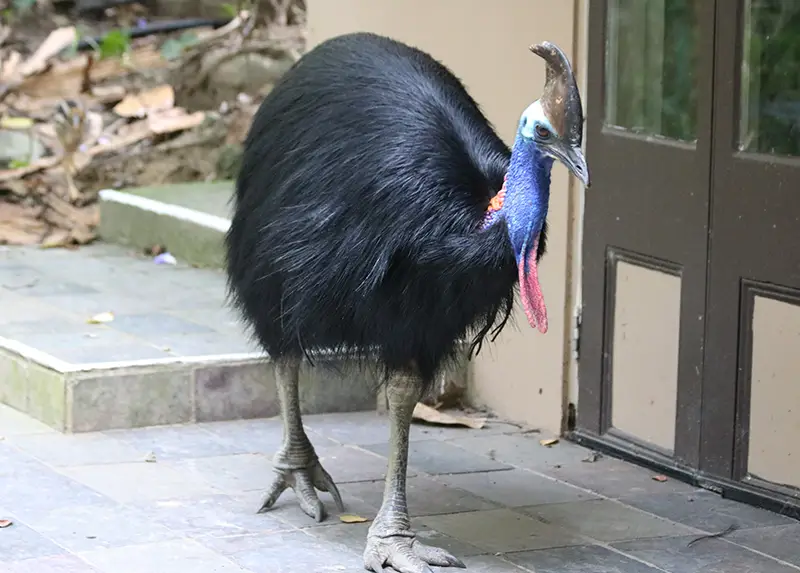
The southern cassowary is a large flightless black bird that can be found in Australia and New Guinea. It belongs to the ratite family, which consists of birds such as emus, ostriches, rheas and kiwis.
The southern cassowary has two wattles (fleshy protrusions) on its neck; this makes it stand out from other species of cassowaries since they usually only have one wattle.
This bird stands at an impressive height of up to 1.5m tall and weighs around 60kg.
They are omnivorous animals but favour fruits over anything else, although they also eat insects, small vertebrates like lizards or snakes and fungi too.
Southern Cassowaries play an important role in maintaining healthy ecosystems by dispersing seeds through their droppings – thus helping forests regenerate naturally.
Scientific classification:
| Kingdom | Animalia |
| Phylum | Chordata |
| Class | Aves |
| Infraclass | Palaeognathae |
| Order | Casuariiformes |
| Family | Casuariidae |
| Genus | Casuarius |
| Species | C. casuarius |
Also Featured In: Most common birds in Australia, Birds You’ll Find in Zoo
3. Rainbow Bee-Eater
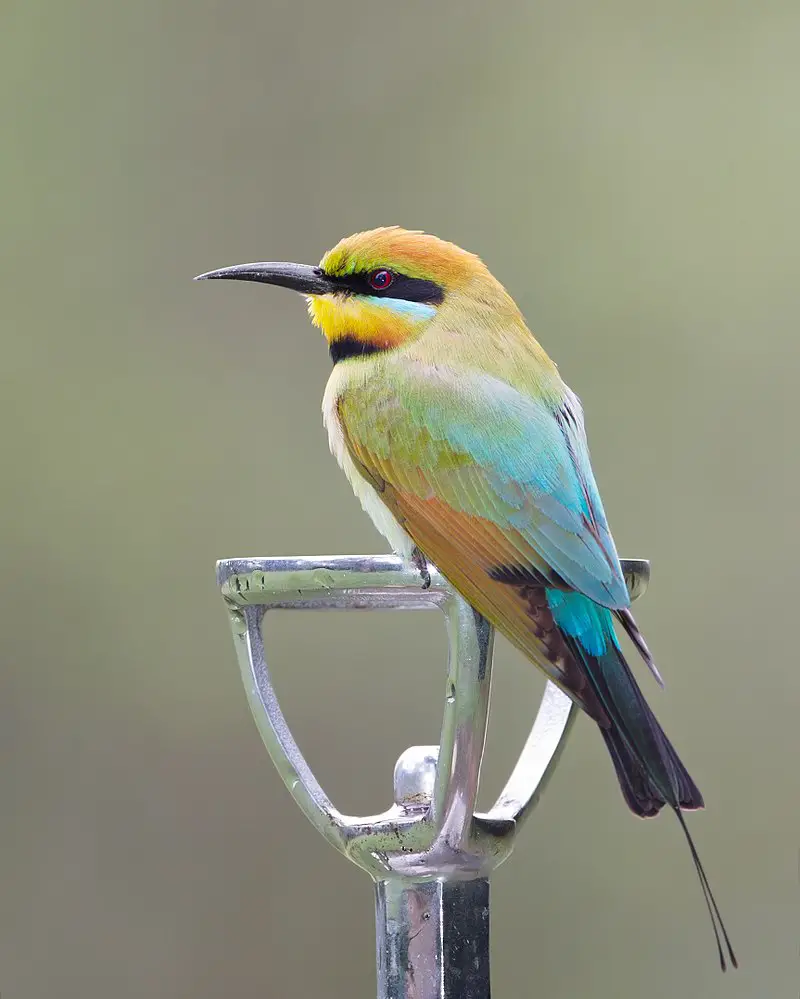
The Rainbow bee-eater (Merops ornatus) is a delightful near passerine bird belonging to the bee-eater family Meropidae.
It is found exclusively in Australia, making it one of only two species of its kind throughout the world; its closest relative being located in Southern and Eastern Africa – the olive bee-eater (Merops superciliosus).
Its stunning plumage features a unique palette of colours including shades pinkish reds, blues, greens and yellows which make for an impressive display when seen up close.
Due to their diet consisting mainly on bees and other insects they have adapted specialised beaks with serrated edges that allow them to easily capture their prey mid flight.
A truly remarkable sight indeed.
Scientific classification:
| Kingdom | Animalia |
| Phylum | Chordata |
| Class | Aves |
| Order | Coraciiformes |
| Family | Meropidae |
| Genus | Merops |
| Species | M. ornatus |
Also Featured In: Birds that Live around Brisbane, Birds that Charles Darwin Studied
4. Orange-Footed Scrubfowl

The Orange-footed Scrubfowl is a small Megapode of the family Megapodiidae found in several islands from Lesser Sunda Islands to southern New Guinea and northern Australia.
It has a dark brown coloration with bright orange legs and feet that stand out against its body, making it quite an eye-catching species.
The bird’s size is roughly equal to that of a domestic chicken.
This species feeds mainly on insects, fruits, seeds and roots but will also scavenge for carrion or feed on worms when available.
They are typically solitary birds except during breeding season when they tend to form colonies near their nesting sites usually along beaches or sand dunes where they can use the heat generated by the sun reflecting off the sand in order to incubate their eggs without having build nests themselves.
Overall this unique bird stands apart from other members of its family due to its striking plumage as well as being one of few ground dwelling megapodes instead of tree dwellers like most others within this group which makes them relatively easy to spot among greenery if you know what you’re looking for.
Scientific classification:
| Kingdom | Animalia |
| Phylum | Chordata |
| Class | Aves |
| Order | Galliformes |
| Family | Megapodiidae |
| Genus | Megapodius |
| Species | M. reinwardt |
Also Featured In: Common Townsville Birds, Native Birds Of Mackay
5. Bush Stone-Curlew
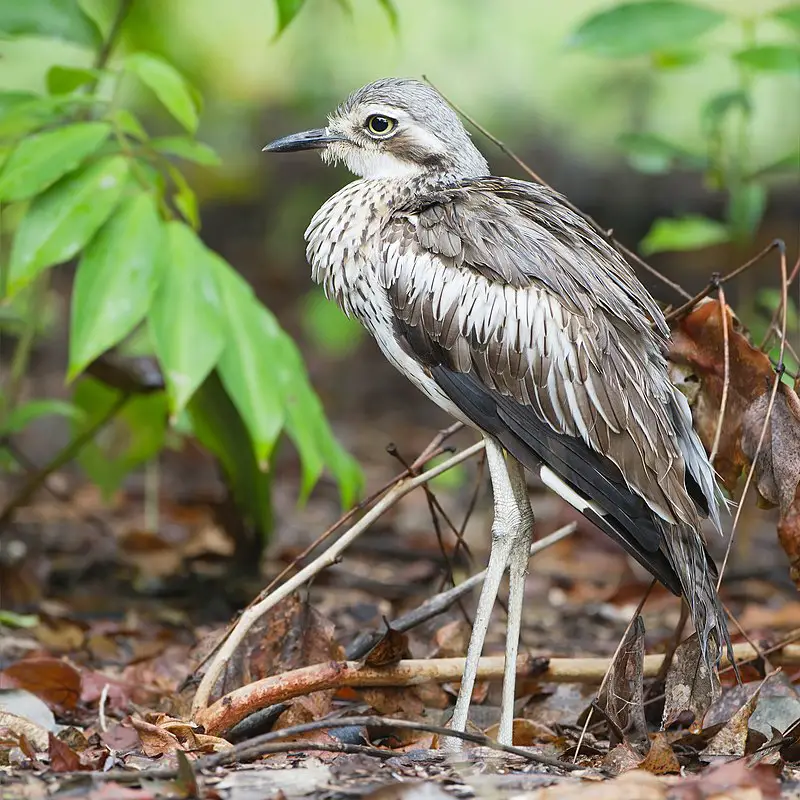
The Bush Stone-Curlew, also known as the Iben Bird, is an endemic species of Australia found in open plains and woodlands. It has grey-brown coloration with dark streaks and large eyes, making it easy to identify.
During night time this bird looks for invertebrates such as insects by slowly stalking its prey. Its long legs allow it to easily traverse across vast landscapes while hunting for food.
The Bush Stone-Curlew plays a vital role in maintaining balance within the ecosystem through controlling insect population growth which can be damaging if not monitored carefully.
Unfortunately due to human interference this species has become endangered so all efforts should be made towards conserving them before they are lost forever from our planet’s biodiversity.
Scientific classification:
| Kingdom | Animalia |
| Phylum | Chordata |
| Class | Aves |
| Order | Charadriiformes |
| Family | Burhinidae |
| Genus | Burhinus |
| Species | B. grallarius |
Also Featured In: Queensland Birds You Should Know, Birds that Live in Gold Coasts
6. Azure Kingfisher
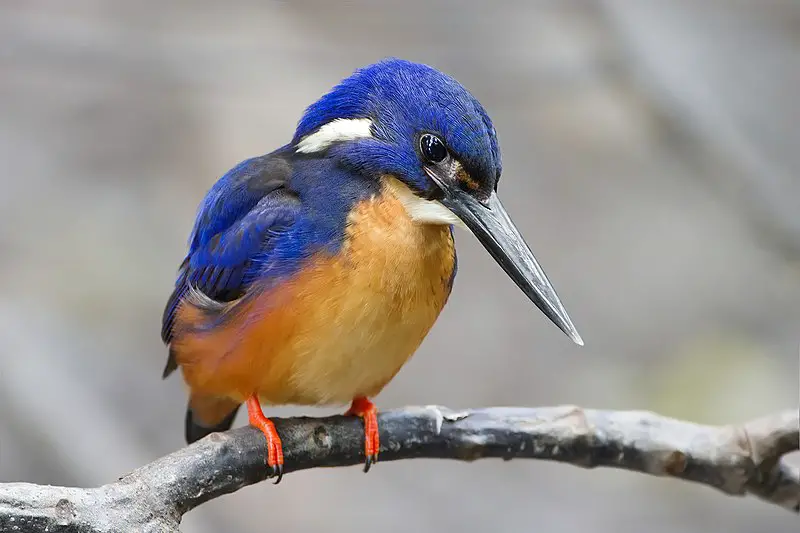
The Azure Kingfisher is a small and beautiful bird, easily recognized by its deep blue to azure back. It measures 17–19 cm in length with males weighing 29-32g and females 31-35g.
On the side of its neck there are large white to buff spots which further adds to the beauty of this species.
This kingfisher inhabits freshwater streams and rivers throughout Australia as well as New Guinea where it can be seen perching on branches next to water bodies or diving for food such as fish, frogs, aquatic insects, molluscs etc.
The Azure Kingfisher has an important role in maintaining healthy river ecosystems while also providing enjoyment when observed in their natural habitats.
Scientific classification:
| Kingdom | Animalia |
| Phylum | Chordata |
| Class | Aves |
| Order | Coraciiformes |
| Family | Alcedinidae |
| Subfamily | Alcedininae |
| Genus | Ceyx |
| Species | C. azureus |
Also Featured In: Kingfishers Species, Birds that Found in Kakadu National Park
7. Pied Imperial Pigeon
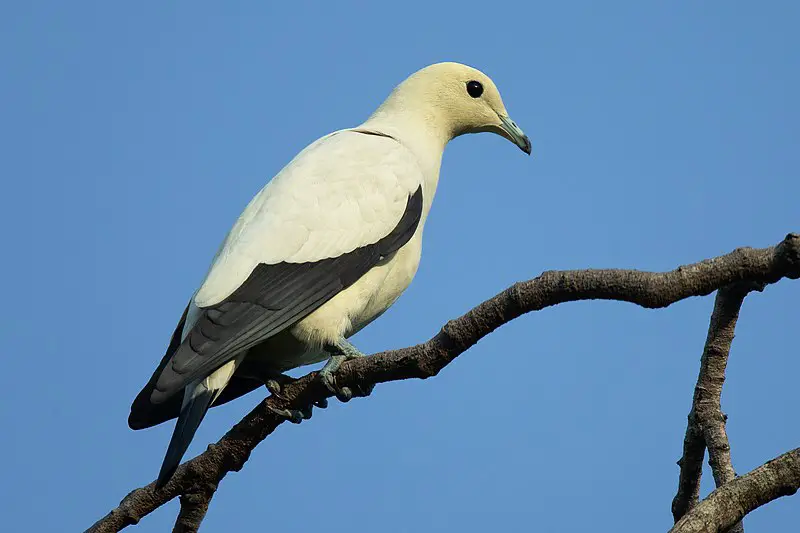
The Pied Imperial Pigeon is a stunning bird native to Southeast Asia. It has striking black and white plumage, with the lower half of its body being predominantly white while its head, neck and upper breast are black.
This species can be found in various habitats such as forests, woodlands, mangroves, plantations and scrub across Myanmar, Thailand Indonesia Philippines & New Guinea regions.
They mainly nest on small islands or coastal areas near coral reefs where they feed primarily on fruits like figs but also occasionally insects & crustaceans too.
These birds form large flocks during breeding season which makes them an impressive sight to behold.
Scientific classification:
| Kingdom | Animalia |
| Phylum | Chordata |
| Class | Aves |
| Order | Columbiformes |
| Family | Columbidae |
| Genus | Ducula |
| Species | D. bicolor |
Also Featured In: Pigeons Species, Beautiful Birds Found in Coron Island
8. Wompoo Fruit Dove
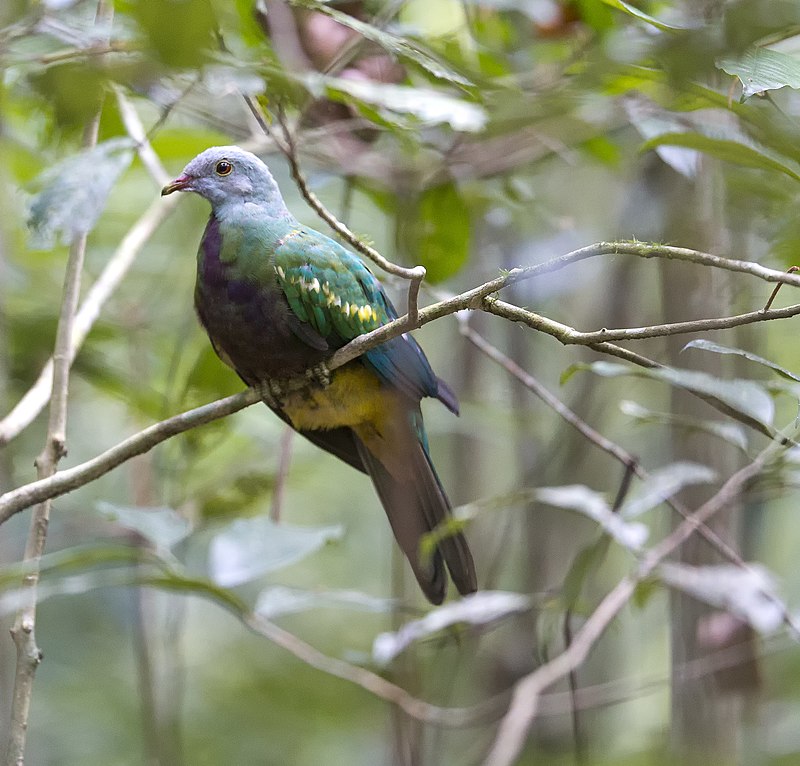
The Wompoo Fruit Dove is a beautiful bird native to New Guinea and eastern Australia. It has an impressive wingspan of up to 45 cm, although they tend to be much smaller in the northern regions.
The dove’s plumage varies from purple around its neck, chest and upper belly, with greyish-brown feathers covering the rest of its body.
This species lives mainly on fruit but will occasionally feed on insects for extra protein and nutrition.
They can also often be seen sipping nectar from flowers or drinking water off leaves in humid rainforest environments.
Although these birds are not currently threatened by extinction, their numbers have decreased due to deforestation of their natural habitats as well as hunting pressure from humans living near them.
Fortunately however conservation efforts are being made across many areas which may help ensure that this lovely species survives into future generations.
Scientific classification:
| Kingdom | Animalia |
| Phylum | Chordata |
| Class | Aves |
| Order | Columbiformes |
| Family | Columbidae |
| Genus | Ptilinopus |
| Species | P. magnificus |
Also Featured In: birds of purple, Birds that Live in Sunshine Coast
9. Mistletoebird
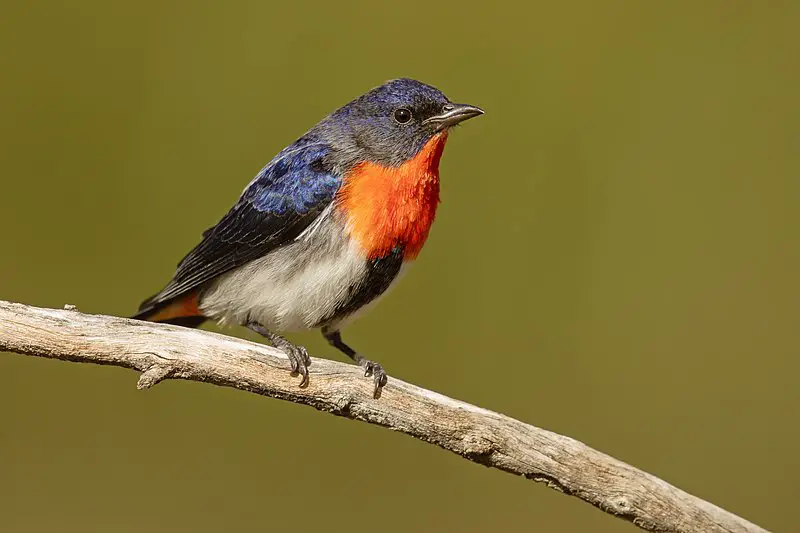
The mistletoebird is a small, colorful bird found in Australia and the eastern Maluku Islands. It feeds mainly on the berries of the parasitic mistletoe and plays a role in the plant’s reproduction by distributing its seeds.
This bird is also known as the mistletoe flowerpecker due to its habit of gathering soft materials to create its nest, which is shaped like a small purse.
The male mistletoebird has a bright red head and chest, while the female has olive-green plumage with a reddish patch on its throat.
Despite its size, this bird has a loud and melodious song. The mistletoebird’s distribution across much of Australia makes it a familiar sight to many Australians, particularly during the holiday season when mistletoe is used as a festive decoration.
Scientific classification:
| Kingdom | Animalia |
| Phylum | Chordata |
| Class | Aves |
| Order | Passeriformes |
| Family | Dicaeidae |
| Genus | Dicaeum |
| Species | D. hirundinaceum |
Also Featured In: New South Wales Birds You Need to See,
10. Spotted Catbird
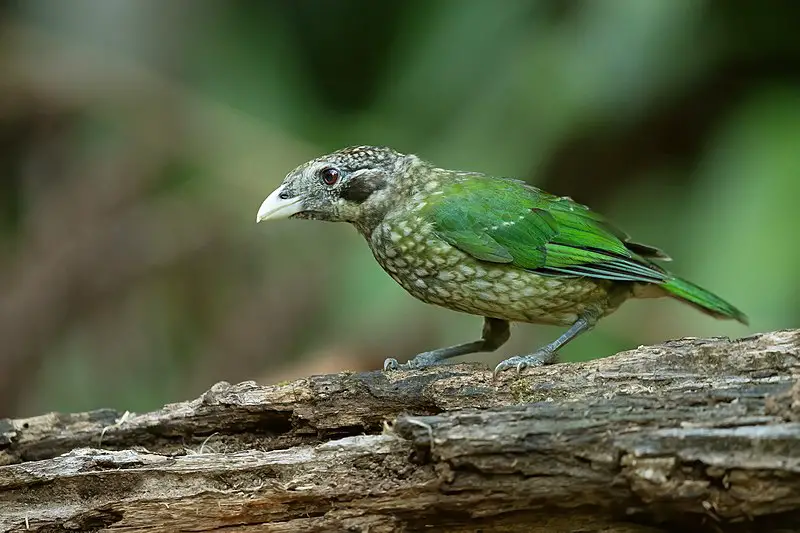
The Spotted catbird is a bird that belongs to the bowerbird family. It can be found in the eastern Moluccas, north Queensland, and New Guinea. Unlike most bowerbirds, it does not create a bower to attract mates.
The Spotted catbird is a commonly seen bird throughout its large range, and as a result, it is listed as a species of “Least Concern” on the IUCN Red List of Threatened Species. This bird has a distinctive spotted appearance, which contributes to its name.
They are opportunistic feeders and eat various fruits, insects, and small reptiles. Their habitat includes rainforests and areas with tall grasses. Their population numbers are steady, and they face no major threats.
Scientific classification:
| Kingdom | Animalia |
| Phylum | Chordata |
| Class | Aves |
| Order | Passeriformes |
| Family | Ptilonorhynchidae |
| Genus | Ailuroedus |
| Species | A. maculosus |
Also Featured In: Rainforest Birds You Should Know, Birds Typically Found in Australian Rainforest
11. Pale-Yellow Robin
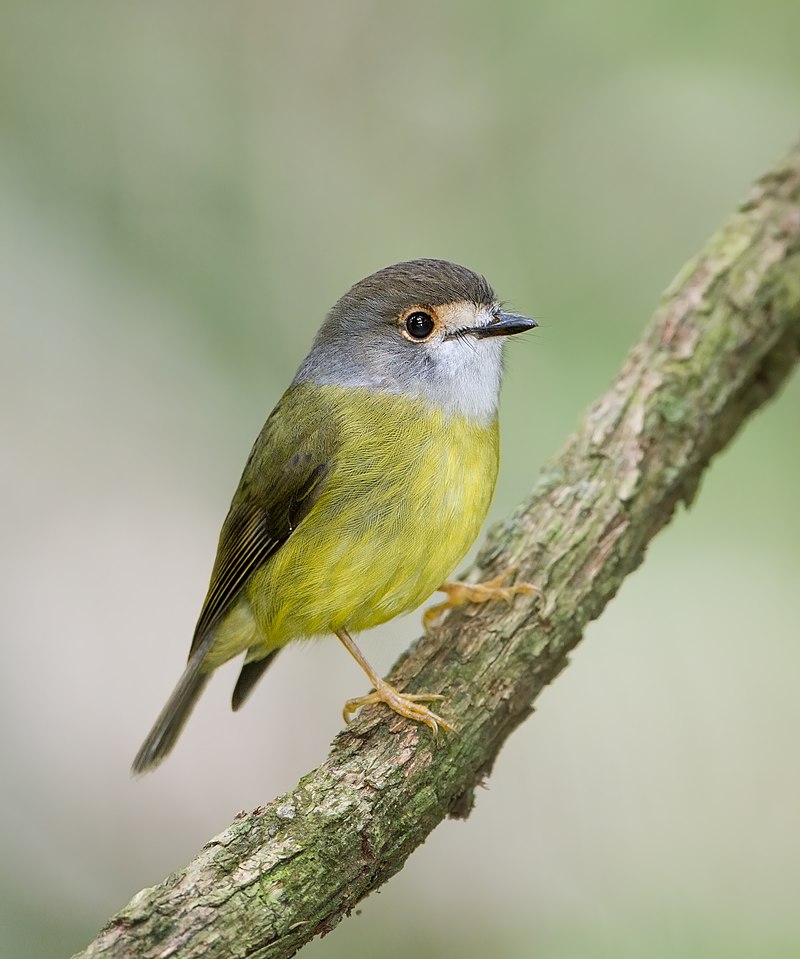
The Pale-yellow robin is a species of passerine bird found only in eastern Australia. It lives in moist lowland forests and has a grey head with olive upperparts and yellow underparts.
Both male and female have similar appearance. It is a nondescript bird with white throat. The bird is small and comes in two subspecies, with the smaller one known as nana found in North Queensland.
Scientific classification:
| Kingdom | Animalia |
| Phylum | Chordata |
| Class | Aves |
| Order | Passeriformes |
| Family | Petroicidae |
| Genus | Tregellasia |
| Species | T. capito |
12. Metallic Starling
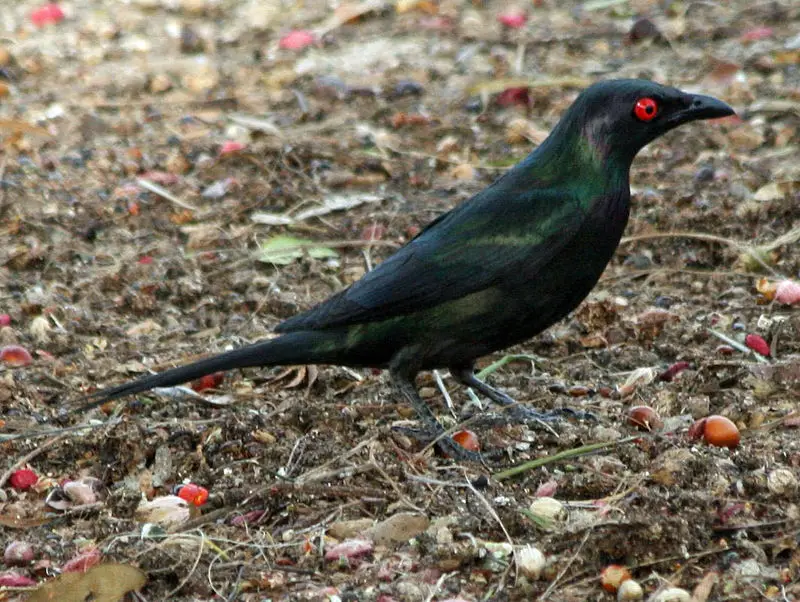
The Metallic Starling, also known as the Shining Starling, is a striking bird found in the Moluccas, New Guinea, Queensland, and the Solomon Islands. Its glossy black plumage, forked tail, and red eyes make for a distinct appearance.
Immature birds have pale undersides with dark streaks. These birds are highly social and build messy, globular nests in tall trees. Despite their impressive appearance, very little is known about the Metallic Starling’s behavior or population status.
Unfortunately, like many birds, they face threats from habitat loss and human activity. Nevertheless, for those lucky enough to spot one, the Metallic Starling is a visually stunning bird that glows in the sunlight.
Scientific classification:
| Kingdom | Animalia |
| Phylum | Chordata |
| Class | Aves |
| Order | Passeriformes |
| Family | Sturnidae |
| Genus | Aplonis |
| Species | A. metallica |
13. Yellow Honeyeater
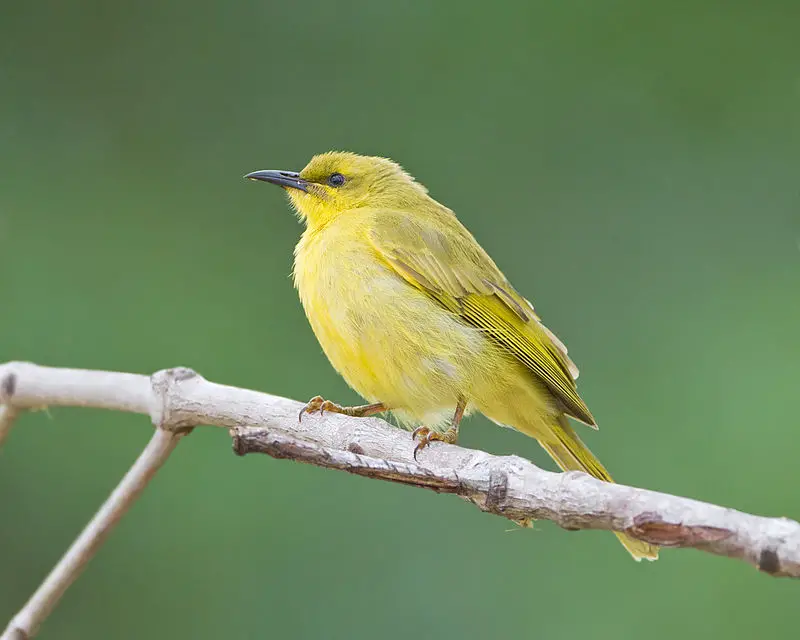
The Yellow honeyeater bird is a unique species found only in Australia that belongs to the family Meliphagidae. It can be spotted in subtropical or tropical moist lowland forests, as well as mangrove forests.
This bird feeds on the nectar of flowers and is attracted to the Coelandria smillieae plant, also known as the bottlebrush orchid.
During the month of August in northern Queensland, the bird can be seen hovering in front of these beautiful flowers.
With its vibrant yellow coloring and small size, the Yellow honeyeater stands out in the dense foliage of its habitat.
Overall, this bird is a fascinating and important component of Australia’s diverse wildlife.
Scientific classification:
| Kingdom | Animalia |
| Phylum | Chordata |
| Class | Aves |
| Order | Passeriformes |
| Family | Meliphagidae |
| Genus | Stomiopera |
| Species | S. flava |
14. Black Butcherbird
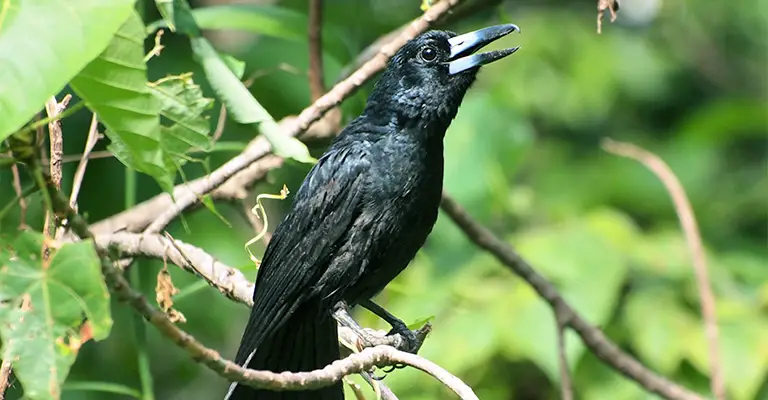
The black butcherbird, also known as Melloria quoyi or Cracticus quoyi, belongs to the Artamidae family of birds. Native to Australia, Indonesia, and Papua New Guinea, it inhabits subtropical or tropical dry and moist forest, as well as mangrove forests.
In a 2013 molecular study, evidence was found that suggests the black butcherbird may actually be closely related to the Australian magpie rather than other species of butcherbirds.
These medium-sized birds are identifiable by their striking black plumage and hooked bills, which they use to catch prey such as lizards, insects, and small mammals.
The black butcherbird is known for its distinctive and melodious song, and is a popular bird for birdwatchers and nature enthusiasts.
Scientific classification:
| Kingdom | Animalia |
| Phylum | Chordata |
| Class | Aves |
| Order | Passeriformes |
| Family | Artamidae |
| Genus | Melloria (Mathews, 1912) |
| Species | M. quoyi |
15. Radjah Shelduck
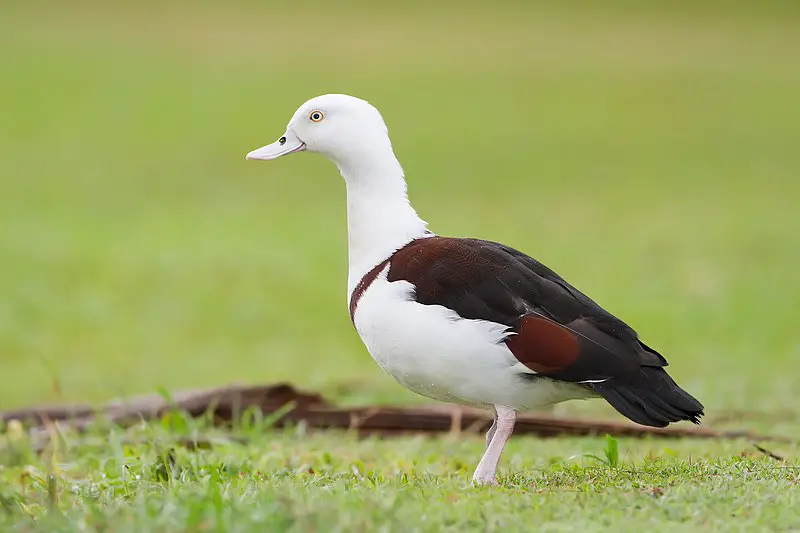
The Radjah shelduck is a unique bird species found mostly in New Guinea and Australia, as well as some of the Moluccas. It has several common names, such as raja shelduck, black-backed shelduck, and Burdekin duck in Australia.
The bird’s name, radjah, comes from the Moluccan people’s name for it on the island of Buru in Indonesia. This species was formerly classified in the genus Tad but is now considered a shelduck.
The Radjah shelduck possesses distinct physical features that set it apart from other waterfowl, including a black head and hindneck with a white throat and forehead.
It is a fascinating bird known for its unique calls and behaviors, which are specific to its habitat and environment.
The conservation status of the Radjah shelduck is currently of least concern as their populations are relatively stable.
Scientific classification:
| Kingdom | Animalia |
| Phylum | Chordata |
| Class | Aves |
| Order | Anseriformes |
| Family | Anatidae |
| Genus | Radjah Reichenbach, 1853 |
| Species | R. radjah |
16. Macleay’s Honeyeater
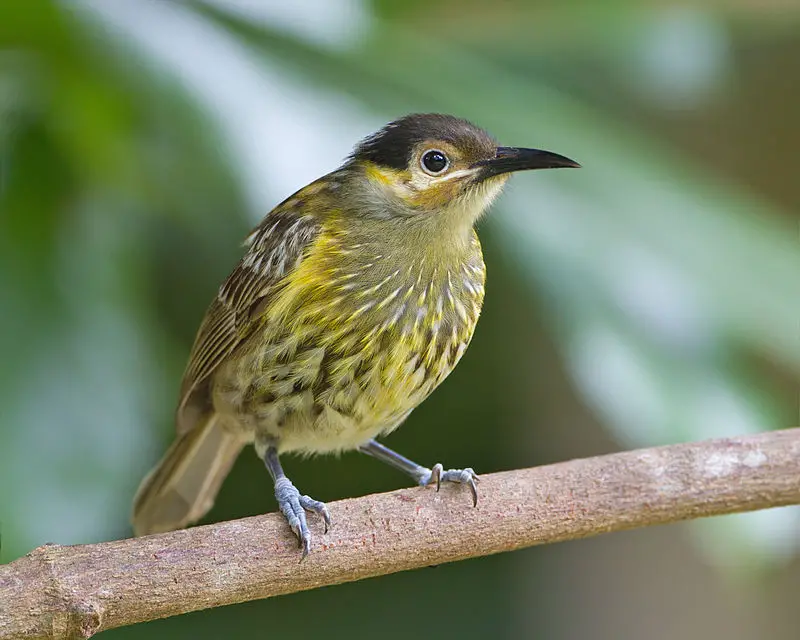
Macleay’s honeyeater, a unique bird species found only in northern Queensland in Australia, is a beautiful sight to behold. With its vibrant colors and distinct appearance, it has captured the hearts of bird enthusiasts worldwide.
It thrives in tropical dry forests and moist lowland forests and is known for its distinctive high-pitched call.
Despite its limited distribution within Australia, Macleay’s honeyeater is an important member of the ecosystem and plays a significant role in pollinating flowers and dispersing seeds.
As a result, conservation efforts have been put in place to protect and preserve this precious bird species.
Scientific classification:
| Kingdom | Animalia |
| Phylum | Chordata |
| Class | Aves |
| Order | Passeriformes |
| Family | Meliphagidae |
| Genus | Xanthotis |
| Species | X. macleayanus |
17. Pacific Baza
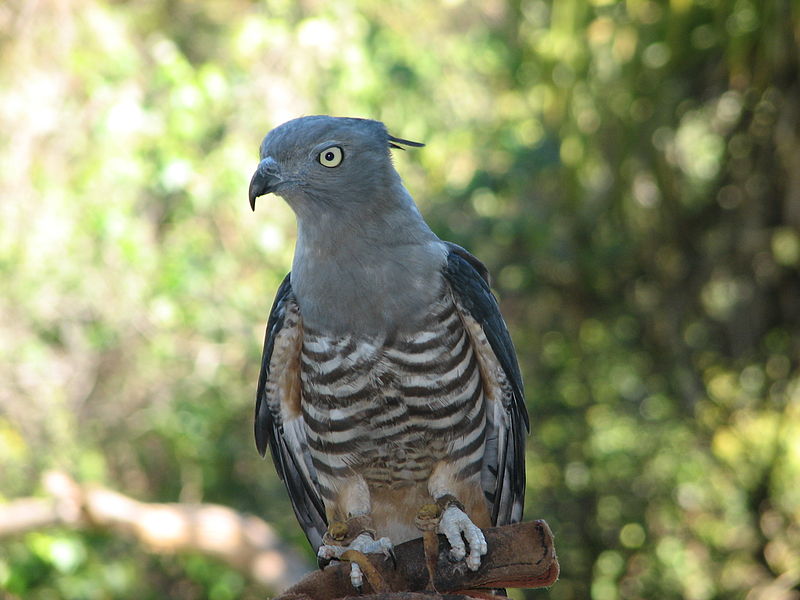
The Pacific baza is a medium-sized bird belonging to the Accipitridae family. It has a grey, brown, and white plumage and can grow up to 46 centimetres in length.
This species is an omnivore and does not typically migrate. Breeding season for the Pacific baza occurs from September to at least January. This bird is also known as the crested hawk, crested baza, and Pacific cuckoo-falcon.
Scientific classification:
| Kingdom | Animalia |
| Phylum | Chordata |
| Class | Aves |
| Order | Accipitriformes |
| Family | Accipitridae |
| Genus | Aviceda |
| Species | A. subcristata |